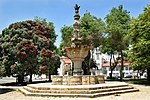Lighthouse of São Miguel-o-Anjo
Buildings and structures in PortoLighthouses in PortugalProperties of Public Interest in Portugal

The Lighthouse of São Miguel-o-Anjo (Portuguese: Farol de São Miguel-o-Anjo) is a former hermitage and 16th century lighthouse, in the civil parish of Aldoar, Foz do Douro e Nevogilde, municipality of Porto, in the Portuguese Norte Region. The lighthouse of São Miguel-o-Anjo is Portugal's oldest existing lighthouse and one of the oldest in Europe. Designed by Italian architect Francesco da Cremona, the project was completed in 1538.
Excerpt from the Wikipedia article Lighthouse of São Miguel-o-Anjo (License: CC BY-SA 3.0, Authors, Images).Lighthouse of São Miguel-o-Anjo
Rua do Passeio Alegre, Porto Foz do Douro (Aldoar, Foz do Douro e Nevogilde)
Geographical coordinates (GPS) Address Nearby Places Show on map
Geographical coordinates (GPS)
| Latitude | Longitude |
|---|---|
| N 41.147111111111 ° | E -8.6667222222222 ° |
Address
Capela-Farol de São Miguel-o-Anjo
Rua do Passeio Alegre
4150-574 Porto, Foz do Douro (Aldoar, Foz do Douro e Nevogilde, Foz Velha)
Portugal
Open on Google Maps









